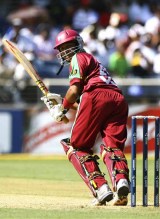
|

'Real fans of the game can still appreciate a quality contest between bat and ball, a duel that separates the men from the boys'
© AFP
|
|
Even in this era of wanton extravagance and shameless greed, quality still prevails over quantity when it really matters.
Much has been made about the International Cricket Council's concern about pitch preparation for their World Cup extravaganza here in the Caribbean. In keeping with a mandate to produce surfaces encouraging free scoring and an average of 500 runs per 100-over match, the ICC have had their man, Andy Atkinson, around and about for the past year ensuring that fans will be thoroughly exhausted with all the jumping up and waving at an unending succession of boundaries.
In that context, it would be interesting to know what is the official verdict on the pitch for yesterday's opener at Sabina Park, a relatively low-scoring affair in the general context of contemporary one-day international cricket that would have fallen below the desired standard, even if the Pakistanis had recovered from a poor start to surpass West Indies' total of 241 for 9.
So was it all boring stuff then, especially if the match ended in an emphatic victory for either side? Only if you buy into the foolish notion that the quality of an ODI is measured in relation to the number of runs scored.
Those who crave the Party Stand atmosphere may revel in a run-spree on a flat track that makes quality pacers and spinners nothing more than the human equivalents of bowling machines, but the real fans of the game can still appreciate a quality contest between bat and ball, a duel that separates the men from the boys and allows the really class players to emerge head and shoulders above the maddening crowd of mediocre overnight heroes.
There also has to be a special motivation to challenge the real champions to lift their game more than a few notches. A World Cup held every four years, as distinct from just another five-match series during just another tour, is precisely that. Even if many are weary of the repetitive ODI treadmill, the advent of the premier competition in the sport is enough to get the adrenaline pumping among even battle-hardened veterans.
Several attempts have been made in recent years to spruce up the one-day game, to breathe some life into the passage of play known as the middle overs, the period where the game just seems to meander along with the batting team either building on a solid platform or consolidating after a poor start. However, instead of experimenting with a succession of innovations, the sport's governing body should be more concerned with the middle ODIs.
These are the matches that don't really matter to anybody, except that it stuffs more money into the pockets of the administration, sponsors, television networks and players. If it's not a tri-nation "Superhero Cup" here, it's a seven-match "Ironman Series" there, all played to packed audiences, the majority of whom have come to watch runs, runs and more runs. No recent series better exemplified that policy of financial expediency than the West Indies' four-match series in India last January.
Nothing about it, except the money for a bankrupt West Indies Cricket Board, made sense. Logic should have dictated that the matches, if they were so imperative, be played in the Caribbean as an ideal prelude and acclimatisation to the conditions to be expected for the World Cup. But the game, as with most other major international sports, operates on a logic defined by revenues.
Take football for example, the pastime that has redefined the very essence of naked greed. All the big clubs-Real Madrid, Chelsea, AC Milan- strenuously resist releasing their big-name players for international duty, claiming that they are paying extravagant wages for players who are burnt out due to their commitments to country. Yet all of these same clubs spend the off-season somewhere in Asia or North America playing some forgettable exhibition tournament, boosting their bank balances by putting the same exhausted players on show.

|

The counter-attacking of Ramnaresh Sarwan was just one of the qualities to appreciate in
the duel at Sabina Park
© AFP
|
|
Which is why, amid the occasional expansive stroke for six, there was much to appreciate in the quality and intensity of yesterday's curtain-raising duel at Sabina Park: from the early strikes by the Pakistani seamers, to the counter-attacking of Sarwan and Samuels, to the cautious class of Lara and even the outrageous strokeplay of Smith nearing the end of the home side's innings.
This is the real beauty of the game of cricket, for it is overflowing with so many dimensions and sub-plots that there is something in it for everybody. Smith's never-ending quest to deposit the white ball near the foothills of the Blue Mountains contrasted sharply with the refined strokeplay of Lara, whose very, very late cut for four out of the gloves of wicketkeeper Kamran Akmal would have warmed the hearts of those who could recall, 40 years to the day of his passing, the late Sir Frank Worrell's equally elegant execution of the same shot.
Similar strokes would have been played and superb spells would have been bowled many times over the years in any number of one-day matches. But, with very few exceptions, hardly any of them are considered memorable unless they occur within a meaningful context.
And that is what the World Cup gives us. For all the glitz, glamour and preoccupation with sponsors' rights, it is a meeting of the best against the best for a prize that everybody wants and is only up for grabs once every four years.
Quality. That's what we really want.



